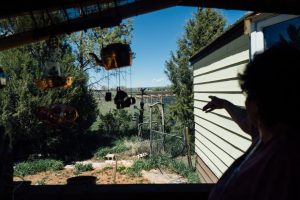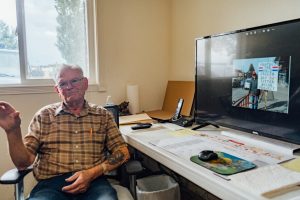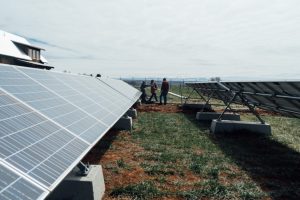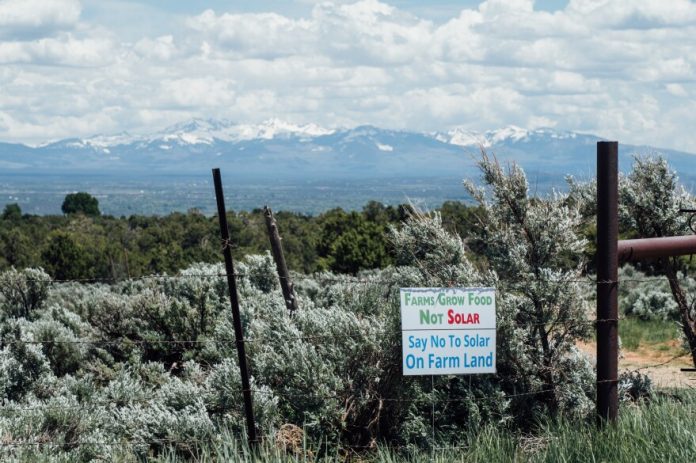Cathy Topper stood at the door to her house looking over the field of solar panels visible from just about anywhere on her property.
“I finally have gotten to the point where I don’t cry all the time,” she said, as we sat at her kitchen table.
The shades were drawn throughout the house so she wouldn’t have to see the solar array while going about her day.
Solar farms have been popping up all around Montezuma County, Colorado, over the past few years. Montezuma County, sitting at 6,000-7,000 feet in elevation, gets 300+ days of sun a year. With the high elevations keeping temperatures cooler, and a significant amount of sun, the region is an ideal place for solar development.
Topper has lived in her house on agricultural land outside Cortez, Colorado, in the Four Corners region for 31 years. She hopes to pass down the house and land to her son. She said it was a peaceful place to live, with views of the fields to the north and Sleeping Ute Mountain to the southwest.

Cathy Topper points at her view of the Montezuma Solar panels at her home in Montezuma County, Colorado.
That changed in June 2022 when the solar farm, a project of Empire Electric Association (EEA), began construction. Since then, Topper said the sound of jackhammers has filled the air every day, seven days a week.
A Long List of Concerns
The location of solar development can be a major point of contention for residents, especially those who have to look at solar projects every day. For Topper, the issue is about the way the installation has disrupted the peace of her rural life. But people have other concerns about solar installations, including solar arrays installed on irrigated agricultural land, which render it useless for agricultural production.
In 2004, Colorado was the first state to enact a renewable energy standard (RES), requiring 30% renewable energy for investor-owned utilities, and 10% or 20% for municipalities and electric cooperatives. Rural electric coops, including Montezuma County’s Empire Electric Association, and Tri-State Generation and Transmission Association, where Empire Electric buys most of their electricity, have been ramping up their transition toward renewable energy in the past few years.
Mike Conne, who lives adjacent to another Empire Electric solar array at Totten Lake, was worried about wildlife in the area and how the solar project would affect the animals. During the permitting process for the Totten Lake solar project, Conne attempted to convince the county that the solar project should go elsewhere, on the Bureau of Land Management (BLM) land, away from residential and agricultural land. However, the land used for the Totten Lake solar project was already owned by Empire Electric. “It made economic sense to use that property to generate additional revenue for our members through a lease with the array developer,” said Empire Electric in an email.
One of Conne’s biggest concerns was the bald eagle nest next to the Empire Electric-owned property. Colorado Parks and Wildlife recommends placing any development at least a quarter mile from any eagle’s nest. OneEnergy quartRenewables, the developer for the Totten Lake project, followed these recommendations and curved the solar project to provide a quarter-mile radius around the nest. OneEnergy also completed construction before nesting season. Now, Conne worries about a housing development going in across the street from the solar array, within the quarter-mile radius of the eagle’s nest.
The Totten Lake solar project was completed and brought online in December 2022. Now, Conne has seen deer get hit by cars because they walk on the road instead of crossing the newly-fenced-off land with the solar array.
Perry Will, a Colorado State Senator for District 5 and former wildlife officer, said that any time you take land out of production by fencing it off, you’re reducing wildlife habitat, especially for ungulates like deer and elk who need fields and sagebrush for critical winter range. “It’s impacting the habitat,” Will said. “It’s really no different than paving it over as a parking lot or putting up a building. It’s still habitat loss.”

Mike Conne shows a photo of himself protesting the Totten Lake Solar project being built near an eagle’s nest on Main Street in Cortez, Colorado.
Conne was also frustrated with the amount of land degradation that took place while the solar construction was underway. “I expected that they were just gonna put the panels over the vegetation. They completely destroyed the whole area,” he said as he showed photos of a machine grading the 12-acre property next to Conne’s house.
In response to questions about landowner concerns, Empire Electric said in an email that “During the permitting phases for both the Totten Lake and Montezuma solar generators there were landowners adjacent to the projects who came forward with concerns about the facilities being built near their homes. EEA [Empire Electric] worked with the solar developer and the county planning and zoning board to ensure the projects complied with statutory requirements and also addressed individual member concerns. In the end, all parties were able to come to terms and the projects were approved. In our opinion, the process allowed members with concerns to have their concerns addressed in a fair manner.”
Topper said that when the solar project was announced, she and her neighbors fought it, but they lost the battle. Nathan Stottler, associate director of project development for OneEnergy Renewables, says that he should have reached out to neighbors earlier in the project development for this specific project. During the permitting process, however, there is built-in time for public comment. When neighbors like Topper came to the public comment meetings with frustrations, OneEnergy did make some allowances like moving the project 50 feet from the property line, building an 8-foot-tall privacy fence (which you can still see over from most spots on Topper’s property), and promising to plant 6-foot tall trees for privacy once the project is finished.
“We’re held to a higher standard than oil and gas because oil and gas is an established use,” said Stottler, “And to the extent we can, we try to welcome that, we want to be better, we want to do better. I work in solar for a reason, because I want to fight climate change.”
A Legal and Logistical Maze
Empire Electric’s contract with Tri-State dictates that the co-op is only allowed to generate up to 5% of its own electricity and must buy the rest from Tri-State. If Empire Electric was able to generate more of its own electricity with solar, electricity prices could go down. But because of the current contract, community members like Topper do not receive any financial benefits from having a solar project in their backyard.
Stottler, who grew up in rural Minnesota, understands how the view of a solar farm is not what residents desire. However, he said that if people see themselves as a part of the regional community and county, there are more direct benefits to having solar installed locally, including keeping money in the community and stabilizing electricity prices.
“OneEnergy is going to be pumping more tax money into Montezuma County, and that’s a big thing that wouldn’t have happened if you were buying your power from out of state or out of county,” said Stottler. Because Empire Electric, a locally owned cooperative, owns these solar farms, anyone who purchases electricity from Empire Electric keeps their dollars in the community instead of sending it out of the county to a coal or natural gas plant elsewhere.
Other Southwestern rural electric coops such as Kit Carson in Taos, New Mexico, and Delta Montrose in Southwest Colorado have bought out of their contract with Tri-State and are now pursuing 100% solar energy during the day, which can stabilize and lower electricity costs for residents.
One of the reasons solar developers choose a specific parcel of land is access to roads, power lines, and substations. If the power is being sold to a transmission company, there need to be transmission lines nearby. The Totten Lake and Montezuma Solar projects are only for distribution through Empire Electric Association, which means they need to be located near Empire Electric owned distribution lines. EEA is not allowed to back feed power onto the transmission grid because of their contract with Tri-State, which means they are only allowed to generate the minimum daytime load (typically determined by the amount of power used from a substation in the middle of the day) and they cannot use Tri-State owned transmission lines to distribute the power produced by the solar arrays.
Stottler said the siting of solar development has three phases.
“It has to be in Empire’s territory, [and] it has to be on their distribution lines,” said Stottler. The project also needs to be adjacent to a substation.
For smaller solar projects like the Montezuma (5 megawatts) and Totten Lake (2.5 megawatts), there is not much wiggle room for moving farther away from distribution lines and substations.
Building new infrastructure isn’t feasible because the profit margins are much smaller than they would be for a larger, transmission-size solar project.

High school students help install a solar array at Fozzies Farm, an educational farm in Montezuma County, Colorado.
“Some of the prime agricultural land is also the prime land for solar energy production because it’s flat and it gets a lot of sun,” said Tyler Garrett, Rocky Mountain Farmers Union’s director of government relations. “The worry is that that [land] will be taken and we’ll be gradually decreasing the amount of land that’s available for agriculture.”
Bob Bragg, Topper’s neighbor and an agricultural journalist, said that it’s important for developers to consider the people who live near solar arrays. “We’re so hellbent on putting in solar installations that we want it close to the substations, when in reality maybe we need to
spend a little bit more money to get those to where they’re not impacting someone’s home who lived there for a very long time,” Bragg told the Daily Yonder.
Garrett worries a lot about farmland being taken out of production with the development of more and more solar farms across the West. He sees agrovoltaics — the marriage of solar and agriculture — to be the best path forward.
One way agrovoltaics can work is to raise solar panels high enough for farming or ranching to take place beneath the solar installation. Colorado-based farm Jack’s Solar Garden is working with the Colorado Agrovoltaic Learning Center to educate farmers and ranchers about what this could look like.
Byron Kominek, director of the Colorado Agrovoltaic Learning Center, agreed. “We have well over 10,000 acres of solar panels in Colorado as far as I understand, and we’re going to have millions of acres of solar panels across our country in the coming years,” said Kominek, “It would be unfortunate if all that land just goes to dirt or weeds or gravel or any degraded state.”
The potential of agrovoltaics is still being explored in Colorado and around the country. In Colorado, a bill was signed on May 19th, 2023, that will provide half a million dollars in grant money for agrovoltaics and conduct a study on the opportunities and challenges with agrovoltaics in Colorado.
Conne said he loves solar but would prefer to see development away from homes and with less land degradation. He said he would support more agrovoltaic development with cattle or sheep to maintain the agricultural nature of rural areas. He sees BLM land as a good opportunity for future solar development as well as landfills. “I love solar, I really do,” said Conne, “but there’s a lot of things that need to be changed in the future.”






